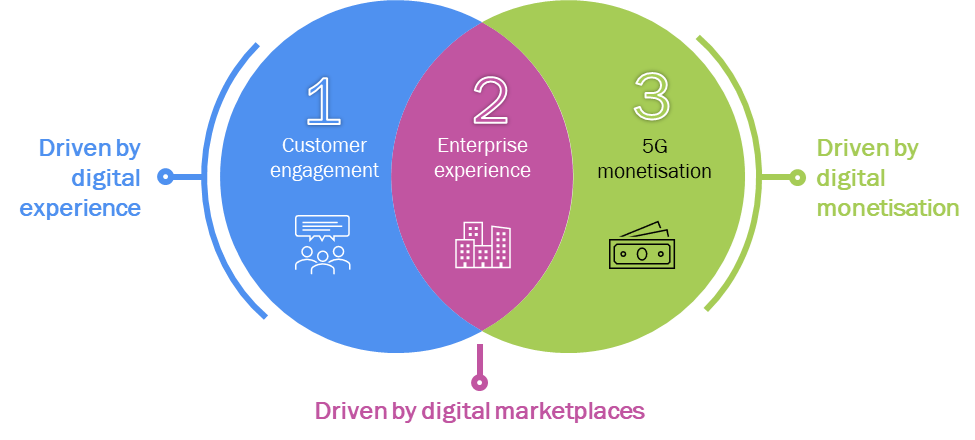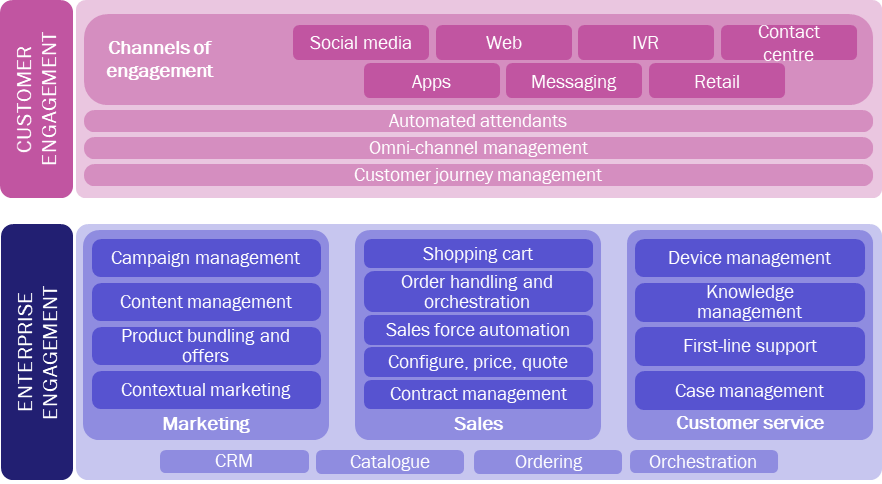The main objective of CSPs, from an architecture design perspective, is to establish an agile, flexible and cost-effective foundation for the future. This is vital for mission-critical, customer-facing functions, especially in the light of rapidly evolving business and operating models. CSPs want to ensure that their investments are futureproof, the architecture is simple and systems operate efficiently at scale. In this regard, CSPs anticipate that the development of an automation friendly, independent, yet interconnected BSS framework will help to lower the cost of operations, improve the time to market and enable participation in a broader value chain. CSPs will embrace a software-oriented operations framework in the long term as 5G standalone becomes more commonplace. This will require agile, configurable and scalable BSS that are compliant with standardised interfaces which can swiftly respond to market changes and new opportunities.
THREE PRIMARY BUILDING BLOCKS OF NEXT-GENERATION BSS
The three fundamental building blocks for BSS of the future are customer engagement, monetisation platforms and digital marketplaces (figure 1). In the long term, CSPs will need to address BSS requirements both holistically and on a component level to ensure that the key capabilities and requirement specifications are satisfied.
Source: Analysys Mason, 2022
DIGITAL CUSTOMER ENGAGEMENT
Transformative digital experience goes beyond intuitive designs and seamless customer journeys. It requires an inside-out transformation of systemic capabilities that enables CSPs to autonomously support interactions over digital channels without having to rely on human intervention. Automation is even more complex to enable for enterprises because it requires synchronisation between multiple cross-domain systems including product catalogue, order management and orchestration. The framework shown in Figure 2 outlines which capabilities are considered to be essential and must co-exist with legacy capabilities that are still in use. In the long term, it is important that any digital customer engagement solution is able to continuously expand its capabilities without affecting ongoing operations.
Source: Analysys Mason, 2022
DIGITAL MONETISATION
The introduction of web-friendly, HTTP/2-based interactions to replace the traditional diameter interfaces is the key factor that is drawing CSPs’ immediate attention to the transformation of their monetisation platforms. This is a very significant change because it affects how events on the CSP network are tracked and charged – CSPs will eventually need to invest in a new converged charging system (CCS) to support the monetisation of 5G applications.
DIGITAL MARKETPLACES
Partner ecosystems and multi-dimensional value chains will play a key role in helping CSPs to unlock the enterprise opportunity. Automation will be crucial for CSPs to effectively address this opportunity, primarily because of the SME segment and the complex requirements of large enterprises, where it is not practical to have separate resources. CSPs will need to engage with an expansive network of partners in order to become key players in the enterprise value chain beyond connectivity, while also bringing together a platform that can support the end-to-end process from onboarding to delivery.
CSPS ARE WELL-POSITIONED TO BECOME A KEY PART OF THE EMERGING DIGITAL VALUE CHAIN ECOSYSTEM
The widespread deployment of 5G standalone will accelerate the adoption of a software-centric operations framework, which will require an agile digital BSS platform. The evolution of the three primary components of BSS (customer engagement, monetisation platforms and digital marketplaces) will be driven by separate but associated factors: an emphasis on digital-first design, a new framework for monetising 5G and the need to support multi-dimensional B2B2X value chains, respectively. Each of these three components will have its own adoption curve and maturity cycle, but CSPs will need to balance the key capabilities of the individual components and the overall BSS architecture in order to achieve their ambitions of improved customer and enterprise engagement and effective monetisation of new opportunities.
Download the full report here.
About the author
John Abraham is a principal analyst with Analysys Mason and leads their digital transformation research, including three research programmes: Customer Engagement, Monetisation Platforms and Digital Experience. His areas of focus include customer journeys and experience, the impact of 5G on BSS systems, telecoms enterprise opportunities, cost transformation, ecosystems and value chains, and micro-services-based architecture models. John has over a decade of experience in the telecoms industry. At Analysys Mason, he has worked on a range of telecoms projects for operators in Africa, Europe, India and the Middle East. Before joining Analysys Mason, he worked for Subex, a BSS vendor, and before that for Dell in India. John holds a bachelor’s degree in computer science from Anna University (India) and an MBA from Bradford University School of Management (UK).



